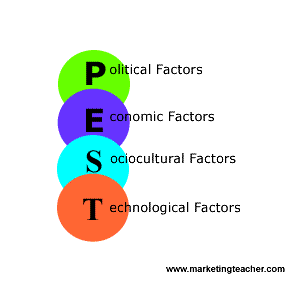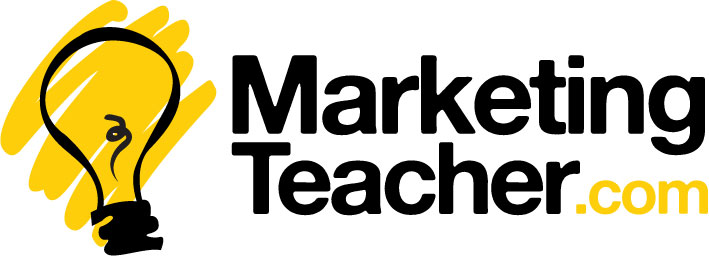PEST Analysis
What is PEST Analysis?
It is very important that an organization considers its environment before beginning the marketing process. In fact, environmental analysis should be continuous and feed all aspects of planning.
Political Factors.
The political environment revolves around the current government in a particular country in which we manufacture or trade, and also laws/legislation operate within your home market as well as overseas. If your government is socialist then perhaps there is a policy to tax more and to invest in the public sector. On the other hand if you have a more conservative or Republican government then the free-market is left to take control, taxation is less and there is often a smaller public sector.
The political arena has a huge influence upon the regulation of businesses, and the spending power of consumers and other businesses. You must consider issues such as:
1.How stable is the political environment?
2.Will government policy influence laws that regulate or tax your business?
3.What is the government’s position on marketing ethics?
4. What is the government’s policy on the economy?
5. Does the government have a view on culture and religion?
6. Is the government involved in trading agreements such as EU, NAFTA, ASEAN, or others?
Economic Factors.
The economic environment is a direct influence on all businesses. Obviously if you are studying marketing there is a huge element of economics within the topic itself, and you should be no stranger to the principles of economics. As we saw from our lesson on the marketing environment there is a macroenvironment, and internal environment and the microenvironment.
More specifically you’ll be at looking elements such as where a business is in terms of the current business cycle, and whether or not you are trading in a recession.
Marketers need to consider the state of a trading economy in the short and long-terms. This is especially true when planning for international marketing. You need to look at:
1. Interest rates.
2. The level of inflation Employment level per capita.
3. Long-term prospects for the economy Gross Domestic Product (GDP) per capita, and so on.

Sociocultural Factors.
The sociocultural environment embodies everything which is social and cultural within a nation or society. There are plenty of examples of society and culture on the marketing teacher website, so we recommend that you go to our lesson store and look through some of the consumer behaviour pages. Some notable examples would include the influence of learning, memory, emotion and perception, motivation, lifestyle and attitude and consumer culture. Have a look at the six living generations in America, social environment and class, the impact of your birth order on how you behave as a consumer and take a look at the eight types of online shoppers.
In a more general sense consider influences such as the increase in life expectation of Western consumers, and demographics which is the study of populations.
The social and cultural influences on business vary from country to country. It is very important that such factors are considered. Factors include:
1.What is the dominant religion?
2.What are attitudes to foreign products and services?
3.Does language impact upon the diffusion of products onto markets?
4.How much time do consumers have for leisure?
5.What are the roles of men and women within society?
6.How long are the population living? Are the older generations wealthy?
7.Do the population have a strong/weak opinion on green issues?
Technological Factors.
Technological
Technological factors are a multifaceted influencer. Let’s just think about the sorts of technology that you come in touch with almost daily. Smart phones such as Android and iPhone are now common – all – garden, and we are used to being able to access information and communication technology instantly no matter where we are. During studies or at work we have access to information on quick PCs and over the Internet, with faster broadband connections arriving in many parts of the world.
Technology also surrounds business processes. As we saw from our lesson on the functions within an organisation all departments use information technology or technology in one form or another. Our manufacturing operations will use technology to produce goods and services. Our logistics and warehousing functions use forklifts and lorries as well as order tracking technology and software. The customer service department will use communication technology to talk to customers but will also have access to internal systems, such as technology to simplify credit control and stock control for example. There are many, many more examples of technology.
Technology is vital for competitive advantage, and is a major driver of globalization. Consider the following points:
1. Does technology allow for products and services to be made more cheaply and to a better standard of quality?
2.Do the technologies offer consumers and businesses more innovative products and services such as Internet banking, new generation mobile telephones, etc?
3.How is distribution changed by new technologies e.g. books via the Internet, flight tickets, auctions, etc?
4.Does technology offer companies a new way to communicate with consumers e.g. banners, Customer Relationship Management (CRM), etc?
The organization’s marketing environment is made up of:
- 1. The internal environment e.g. staff (or internal customers), office technology, wages and finance, etc.
- 2. The micro-environment e.g. our external customers, agents and distributors, suppliers, our competitors, etc.
- 3. The macro-environment e.g. Political (and legal) forces, Economic forces, Sociocultural forces, and Technological forces. These are known as PEST factors.
